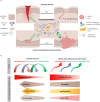Wound healing: insights into autoimmunity, ageing, and cancer ecosystems through inflammation and IL-6 modulation
- PMID: 39676864
- PMCID: PMC11638159
- DOI: 10.3389/fimmu.2024.1403570
Wound healing: insights into autoimmunity, ageing, and cancer ecosystems through inflammation and IL-6 modulation
Abstract
Wound healing represents a complex and evolutionarily conserved process across vertebrates, encompassing a series of life-rescuing events. The healing process runs in three main phases: inflammation, proliferation, and maturation/remodelling. While acute inflammation is indispensable for cleansing the wound, removing infection, and eliminating dead tissue characterised by the prevalence of neutrophils, the proliferation phase is characterised by transition into the inflammatory cell profile, shifting towards the prevalence of macrophages. The proliferation phase involves development of granulation tissue, comprising fibroblasts, activated myofibroblasts, and inflammatory and endothelial cells. Communication among these cellular components occurs through intercellular contacts, extracellular matrix secretion, as well as paracrine production of bioactive factors and proteolytic enzymes. The proliferation phase of healing is intricately regulated by inflammation, particularly interleukin-6. Prolonged inflammation results in dysregulations during the granulation tissue formation and may lead to the development of chronic wounds or hypertrophic/keloid scars. Notably, pathological processes such as autoimmune chronic inflammation, organ fibrosis, the tumour microenvironment, and impaired repair following viral infections notably share morphological and functional similarities with granulation tissue. Consequently, wound healing emerges as a prototype for understanding these diverse pathological processes. The prospect of gaining a comprehensive understanding of wound healing holds the potential to furnish fundamental insights into modulation of the intricate dialogue between cancer cells and non-cancer cells within the cancer ecosystem. This knowledge may pave the way for innovative approaches to cancer diagnostics, disease monitoring, and anticancer therapy.
Keywords: IL-6; cancer-associated fibroblasts; granulation tissue; myofibroblasts; wound healing.
Copyright © 2024 Lacina, Kolář, Pfeiferová, Gál and Smetana.
Conflict of interest statement
The remaining authors declare that the research was conducted in the absence of any commercial or financial relationships that could be construed as a potential conflict of interest.
Figures



Similar articles
-
How Signaling Molecules Regulate Tumor Microenvironment: Parallels to Wound Repair.Molecules. 2017 Oct 26;22(11):1818. doi: 10.3390/molecules22111818. Molecules. 2017. PMID: 29072623 Free PMC article. Review.
-
Autoimmunity, cancer and COVID-19 abnormally activate wound healing pathways: critical role of inflammation.Histochem Cell Biol. 2022 Nov;158(5):415-434. doi: 10.1007/s00418-022-02140-x. Epub 2022 Jul 22. Histochem Cell Biol. 2022. PMID: 35867145 Free PMC article. Review.
-
Macrophages in skin injury and repair.Immunobiology. 2011 Jul;216(7):753-62. doi: 10.1016/j.imbio.2011.01.001. Epub 2011 Jan 8. Immunobiology. 2011. PMID: 21281986 Review.
-
Mechanisms of pathological scarring: role of myofibroblasts and current developments.Wound Repair Regen. 2011 Sep;19 Suppl 1:s10-5. doi: 10.1111/j.1524-475X.2011.00708.x. Wound Repair Regen. 2011. PMID: 21793960 Review.
-
Calpain activity is essential in skin wound healing and contributes to scar formation.PLoS One. 2012;7(5):e37084. doi: 10.1371/journal.pone.0037084. Epub 2012 May 16. PLoS One. 2012. PMID: 22615899 Free PMC article.
Cited by
-
Bark Extracts of Chamaecyparis obtusa (Siebold & Zucc.) Endl. Attenuate LPS-Induced Inflammatory Responses in RAW264.7 Macrophages.Plants (Basel). 2025 Jul 29;14(15):2346. doi: 10.3390/plants14152346. Plants (Basel). 2025. PMID: 40805695 Free PMC article.
-
The Role of Metabolic Disorders and Laboratory Abnormalities in Wound Healing and Recovery in Geriatric and Non-Geriatric Orthopedic Patients in Poland-Prospective Research.J Clin Med. 2025 Jul 28;14(15):5317. doi: 10.3390/jcm14155317. J Clin Med. 2025. PMID: 40806940 Free PMC article.
-
Skin Wound Healing Following Injecting Hyaluronic Acid Rejuvenating Complex, Polycaprolactone, or Combination Therapy: An Experimental Study.J Cosmet Dermatol. 2025 May;24(5):e70221. doi: 10.1111/jocd.70221. J Cosmet Dermatol. 2025. PMID: 40365636 Free PMC article.
References
Publication types
MeSH terms
Substances
LinkOut - more resources
Full Text Sources
Medical

